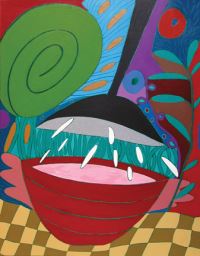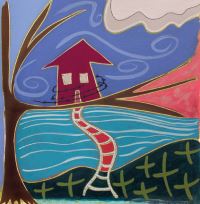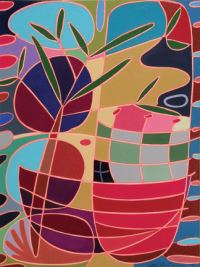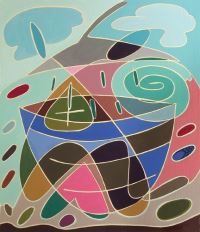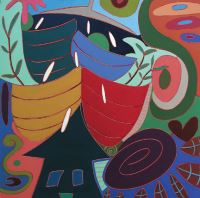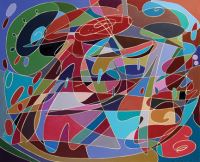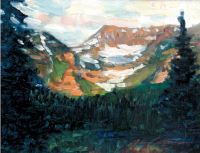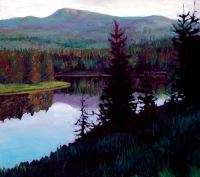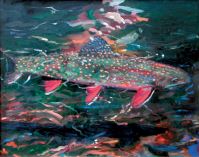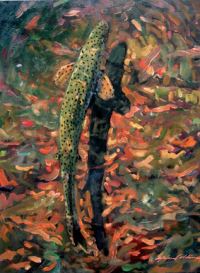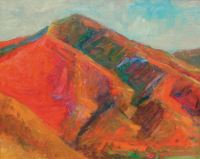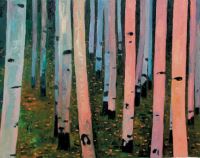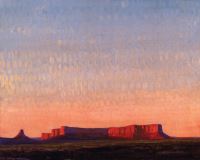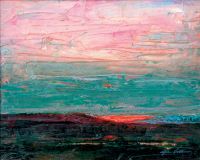Winter 2004, Volume 21.2
Art
Meri DeCaria & John Collins
Mindscapes and Landscapes
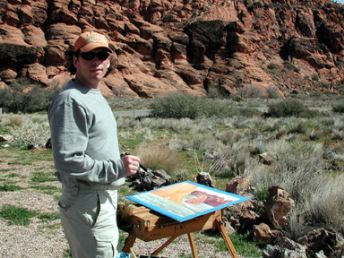
Raised in Utah, John Collins learned much about painting from his sister Chris and his father Gary. He studied fine arts and design at the University of Utah where he developed his interests in printing, design, and illustration. His work is frequently exhibited in galleries and shows throughout Utah. His commissioned murals and paintings can be seen in locales from Florida to Hawaii. Currently, John teaches watercolor classes on river trips along the Colorado and resides in Salt Lake City where he is a freelance artist.
Utah's landscapes, from lush green mountains to red desert cliffs, are a thing of passion and beauty to many, yet for painters… [like] John Collins they are something more, even something in their blood…. From dramatic to subtle, the emphasis of their work falls more on the feeling of a place rather than portraying it in exact detail, more often capturing a time, a temperature and an emotion. …a particular sensitivity to color, such as the cool blue that settles into a shadow on a warm afternoon or an orange hue draping itself over a gathering of trees at dusk. This comes naturally to John…. John has a great love and respect for nature, a relationship with the land [that] is communicated fiercely through his work.
—Jamaica Trinnaman,
Utah Homes and Garden
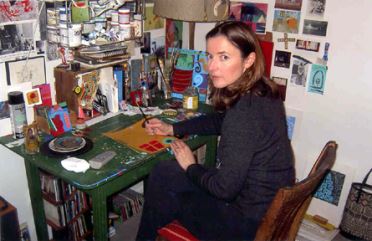
Born in Minneapolis, Meri DeCaria attended the Pratt School of Design in New York. She earned an A.A. degree at the Art Institute of Philadelphia and a BFA at the American College in London. In 1990 she moved to Salt Lake City where she is Director and Curator at Phillips Gallery. Her work includes several commissioned public murals in the downtown Salt Lake City area and is exhibited widely in galleries and shows. An active member of the of the Salt Lake Gallery Association, Ms. DeCaria currently serves on The Utah Museum of Fine Arts' Special Exhibitions Committee as well as the Utah Arts Council Advisory Panel.
Producing art in an age where social commentary and complex, visually difficult imagery are commonplace, Ms. DeCaria chooses to work in a more whimsical manner. Her paintings may even appear to be frivolous (with her use of brightly colored surfaces), but after a moment's notice the viewer can see the topsy-turvy life presented on canvas. Each piece is invested with emotional presence, bringing out energy and life. Images exalt in the space where anxiety and control collide. Vessels gather that which showers forth. Brimming with liquid and propped precariously, they imply a sense of solace and force. Houses that buckle and bend provide armor for those inside, while the flux of life surrounds them.
—David Pursley, Art Curator
Meri DeCaria: Understanding the process of my work helps the viewer to "travel" within each painting: I begin by applying a coat of paint over the whole surface of the canvas. While the paint is still wet, I use the other end of my brush to "etch" into the drying paint. Moving in fluid motion and uninhibited in trying to achieve anything too precise, I lay down a tangle of lines that become my map. Little by little I add color to the spaces. It doesn't take long before I am able to identify images in the web of lines and colors, images that serendipitously create structures of their own. Depending upon the focus that I want a particular painting to take, I highlight or play down these individual shapes. I want those who look closely to discover the peculiar character of these structures and shapes, the colors and spaces. I want people to be drawn to search further into the painting, to see what is intended as well as what is not intended—to "discover" the work, much as I do when I paint it. Allowing the painting to show me what it wants to reveal makes going to my studio an adventure—anticipating the element of surprise is irresistible.
Meri DeCaria: There are recurring symbols imbedded in the flowing organic shapes and vibrant colors of my work: houses (often misshapen and bending), spirals, bowls, flowing showers, vines—all want some interpretation. Perhaps the showers are some substance that nurtures—the full bowl, the vessel of life that waits to satisfy a thirst. Vines might be growth, which really is a gift—houses, the safe shelters that bend and buckle under weight.
Meri DeCaria: Many of my paintings invite a kind of introspection, an investigation of the everyday experiences that make our lives. We live in a chaotic world, and my paintings want to put some order to it—or at least help us understand it. The flowing lines, the colorful spaces, the use of the entire canvas as a "field of play," all of these combine to speak of our vulnerability and need to find some order—they also speak of our ability to find sanctuary and discover that order.
John Collins: Art is magic. It has its own energy and its own power, and it operates a little beyond the artist as well as the viewer. I like to evoke sensations and emotions from the people who view my paintings. It is exciting to see this magic at work—a kind of synergy that develops between the viewer, the painting, and the artist. I paint landscapes, abstracts, and images that have meaning to me. I grew up in the West, in the middle of landscape, and place has always been important to me. I love the changes of the seasons, the textures and smells of the mountains and deserts. I am interested in the variations of light and shade and color that surround me. I often work "on location," painting outdoors and usually in the mornings or evenings when the changes in light and texture can be both subtle and dramatic—sometimes at once. I try to capture these nuances for people who view my paintings. I want them to gather as much pleasure and meaning from my paintings as I do when I paint them.
John Collins: I have painted fish for many years—they fascinate me. My brother-in-law invited me to go fishing with him in Idaho, and that's where I started painting trout. I had traded some paintings for some fishing gear, and while I waited for delivery, I began to look closely beneath the surface of the water. I love the way the water plays with the light—the refracted image almost becomes abstract. I feel the same way about the light that filters through a grove of aspen.
John Collins: The Grand Canyon of the Colorado and the desert of Canyonlands are two of the great landscapes of the world. They display an amazing array of colors and contrasts, and I have done a lot of painting there. Together they have inspired me to look at things in a whole new way—a more abstract way. Recently, I find my work reflecting a more fluid interpretation and re-visioning of shape and color. My painting has become increasingly more abstract as it continues to connect to the landscape.



